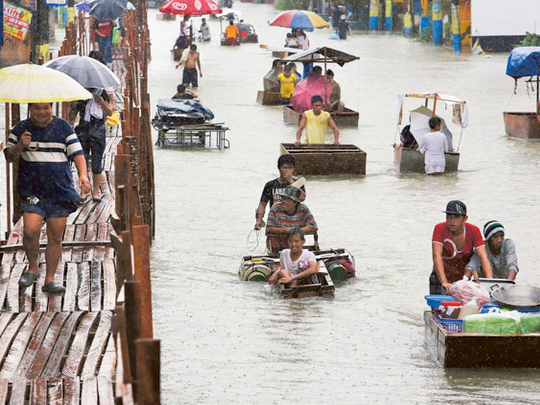
Manila: Three people were reported dead as Typhoon Kai Tak, locally known as Helen and the eighth to enter the country, weakened and moved to northern Luzon’s Aparri, Cagayan on Wednesday, officials said.
One-year old baby Nathalie Jamon drowned in Ilocos Norte, northern Luzon on August 15. Amando Bordon, 37, had epileptic seizure and fell into a flooded rice field in Dumpay Village, Pangasinan, northern Luzon on August 13. On the same day, Andrew Batara, 47, was dragged by a strong current to the centre of a river in Madamba Dingas Village in Ilocos Norte, northern Luzon, Defence Undersecretary Benito Ramos, head of the National Disaster Risk Reduction Management Council (NDRRMC).
A third of Philippines’ three islands (Luzon, Visayas, and Mindanao) continued to absorb water because Typhoon Kai-Tak affected mostly northern areas, exacerbating already flooded places there after 15 days of monsoon-triggered and raging rains due to Typhoons Saola and Hakui that were sea-bound and never landed in upper northern Luzon, said Ramos.
Although Typhoon Kai-Tak’s rain was weak, between 7.5 to 12 mm per hour, it still scoured already water-drenched soils on mountainous areas in northern, central and southern Luzon. “Dreaded landslides could occur anytime in those dangerous areas,” said Ramos.
Kai Tak‘s wind moved 61 to 100 kph, prompting the raising of public storm warning signal number two on all of northern Luzon’s Cagayan, Calayan Group of Islands, Babuyan Group of Islands, Isabela, Northern Aurora, Quirino, Nueva Vizcaya, Benguet, Ifugao, Mt. Province, Ilocos Sur, Apayao, Kalinga, Ilocos Norte, Abra and Batanes Group of Islands, said Ramos.
Kai-Tak’s winds also weakened, at 45-60 kph, in lower areas of Luzon, prompting the hoisting of public storm warning number one on Nueva Ecija, Pangasinan, Tarlac, La Union and the rest of Aurora, said Ramos.
In Metro Manila, roads were surprisingly knee-deep with floods, said Ramos, adding, “Hopefully, the floods would ebb soon as soon as Typhoon Kai-Tak leaves the Philippine territory on Thursday.”
Kai-Tak poured between 7.5 and 12.0 mm of rain per hour on all of northern, central, and southern Luzon, including Metro Manila. Its radius of 50 kilometre affected these areas, including Metro Manila, said the government-run Philippine Atmospheric Geophysical and Astronomical Services Administration (PAGASA).
Seen 40 kilometres south southeast of Aparri, Cagayan, Kai-Tak was moving at west northwest at 13kph, packing maximum sustained winds of 75 kph near the center and with gustiness of up to 90 kph, PAGASA said.
About 21 typhoons damage the country every year.











